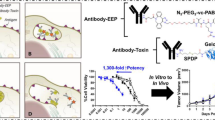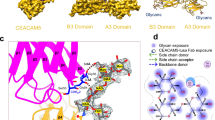Abstract
Theoretical analyses suggest that the cellular internalization and catabolism of bound antibodies contribute significantly to poor penetration into tumors. Here we quantitatively assess the internalization of antibodies and antibody fragments against the commonly targeted antigen carcinoembryonic antigen (CEA). Although CEA is often referred to as a non-internalizing or shed antigen, anti-CEA antibodies and antibody fragments are shown to be slowly endocytosed by LS174T cells with a half-time of 10–16 h, a time scale consistent with the metabolic turnover rate of CEA in the absence of antibody. Anti-CEA single chain variable fragments (scFvs) with significant differences in affinity, stability against protease digestion, and valency exhibit similar uptake rates of bound antibody. In contrast, one anti-CEA IgG exhibits unique binding and trafficking properties with twice as many molecules bound per cell at saturation and significantly faster cellular internalization after binding. The internalization rates measured herein can be used in simple computational models to predict the microdistribution of these antibodies in tumor spheroids.






Similar content being viewed by others
Explore related subjects
Discover the latest articles and news from researchers in related subjects, suggested using machine learning.References
Ackerman M, Chalouni C, Raman V, Schmidt M, Ritter G, Mellman I, Wittrup KD (2008) A33 antigen displays persistent surface expression. Cancer Immunol Immunother (in press)
Adams GP et al (2001) High affinity restricts the localization and tumor penetration of single-chain fv antibody molecules. Cancer Res 61:4750–4755
Adams GP, Weiner LM (2005) Monoclonal antibody therapy of cancer. Nat Biotechnol 23:1147–1157
Austin CD et al (2004) Endocytosis and sorting of ErbB2 and the site of action of cancer therapeutics trastuzumab and geldanamycin. Mol Biol Cell 15:5268–5282
Baxter LT, Jain RK (1991) Transport of fluid and macromolecules in tumors. III. Role of binding and metabolism. Microvasc Res 41:5–23
Beckman RA, Weiner LM, Davis HM (2007) Antibody constructs in cancer therapy: protein engineering strategies to improve exposure in solid tumors. Cancer 109:170–179
Behr TM et al (2000) Therapeutic advantages of Auger electron- over beta-emitting radiometals or radioiodine when conjugated to internalizing antibodies. Eur J Nucl Med 27:753–765
Bryan JN et al (2005) Comparative uptakes and biodistributions of internalizing versus noninternalizing copper-64 radioimmunoconjugates in cell and animal models of colon cancer. Nucl Med Biol 32:851–858
Cai W et al (2007) PET imaging of colorectal cancer in xenograft-bearing mice by use of an 18F-labeled T84.66 anti-carcinoembryonic antigen diabody. J Nucl Med 48:304–310
Casalini P et al (1997) Tumor pretargeting: role of avidin/streptavidin on monoclonal antibody internalization. J Nucl Med 38:1378–1381
Dooley H et al (1998) Stabilization of antibody fragments in adverse environments. Biotechnol Appl Biochem 28(Pt 1):77–83
Fallon EM, Lauffenburger DA (2000) Computational model for effects of ligand/receptor binding properties on interleukin-2 trafficking dynamics and T cell proliferation response. Biotechnol Prog 16:905–916
Fan Z et al (1994) Antibody-induced epidermal growth factor receptor dimerization mediates inhibition of autocrine proliferation of A431 squamous carcinoma cells. J Biol Chem 269:27595–27602
Ford CH et al (1996) Novel flow cytometric analysis of the progress and route of internalization of a monoclonal anti-carcinoembryonic antigen (CEA) antibody. Cytometry 23:228–240
Friedman LM et al (2005) Synergistic down-regulation of receptor tyrosine kinases by combinations of mAbs: implications for cancer immunotherapy. Proc Natl Acad Sci USA 102:1915–1920
Fujimori K et al (1990) A modeling analysis of monoclonal antibody percolation through tumors: a binding-site barrier. J Nucl Med 31:1191–1198
Graff CP et al (2004) Directed evolution of an anti-carcinoembryonic antigen scFv with a 4-day monovalent dissociation half-time at 37 °C. Protein Eng Des Sel 17:293–304
Graff CP, Wittrup KD (2003) Theoretical analysis of antibody targeting of tumor spheroids: importance of dosage for penetration, and affinity for retention. Cancer Res 63:1288–1296
Hammarstrom S (1999) The carcinoembryonic antigen (CEA) family: structures, suggested functions and expression in normal and malignant tissues. Semin Cancer Biol 9:67–81
Hedin A, Hammarstrom S, Larsson A (1982) Specificities and binding properties of eight monoclonal antibodies against carcinoembryonic antigen. Mol Immunol 19:1641–1648
Jain RK (2001) Delivery of molecular and cellular medicine to solid tumors. Adv Drug Deliv Rev 46:149–168
Kraeber-Bodere F et al (2006) Targeting, toxicity, and efficacy of 2-Step, pretargeted radioimmunotherapy using a chimeric bispecific antibody and 131I-labeled bivalent hapten in a phase I optimization clinical trial. J Nucl Med 47:247–255
Kyriakos RJ et al (1992) The fate of antibodies bound to the surface of tumor cells in vitro. Cancer Res 52:835–842
Lee YC et al (2002) Reversible dimer formation and stability of the anti-tumour single-chain Fv antibody MFE-23 by neutron scattering, analytical ultracentrifugation, and NMR and FT-IR spectroscopy. J Mol Biol 320:107–127
Liu G et al (2005) Further investigations of morpholino pretargeting in mice–establishing quantitative relations in tumor. Eur J Nucl Med Mol Imaging 32:1115–1123
Lund KA et al (1990) Quantitative analysis of the endocytic system involved in hormone-induced receptor internalization. J Biol Chem 265:15713–15723
Mattes MJ (2005) Binding parameters of antibodies: pseudo-affinity and other misconceptions. Cancer Immunol Immunother 54:513–516
Mayor S, Rothberg KG, Maxfield FR (1994) Sequestration of GPI-anchored proteins in caveolae triggered by cross-linking. Science 264:1948–1951
Paxton RJ et al (1987) Sequence analysis of carcinoembryonic antigen: identification of glycosylation sites and homology with the immunoglobulin supergene family. Proc Natl Acad Sci USA 84:920–924
Rao BM, Lauffenburger DA, Wittrup KD (2005) Integrating cell-level kinetic modeling into the design of engineered protein therapeutics. Nat Biotechnol 23:191–194
Reiter Y et al (1996) Engineering antibody Fv fragments for cancer detection and therapy: disulfide-stabilized Fv fragments. Nat Biotechnol 14:1239–1245
Sharma SK et al (2005) Sustained tumor regression of human colorectal cancer xenografts using a multifunctional mannosylated fusion protein in antibody-directed enzyme prodrug therapy. Clin Cancer Res 11:814–825
Shih LB et al (1994) Internalization of an intact doxorubicin immunoconjugate. Cancer Immunol Immunother 38:92–98
Stein R et al (1999) Carcinoembryonic antigen as a target for radioimmunotherapy of human medullary thyroid carcinoma: antibody processing, targeting, and experimental therapy with 131I and 90Y labeled MAbs. Cancer Biother Radiopharm 14:37–47
Sung C, van Osdol WW (1995) Pharmacokinetic comparison of direct antibody targeting with pretargeting protocols based on streptavidin–biotin binding. J Nucl Med 36:867–876
Thurber G, Wittrup KD (2008) Quantitative spatiotemporal analysis of antibody diffusion and endocytic consumption in tumor spheroids. Cancer Res (in press)
Thurber G, Zajik SC, Wittrup KD (2007) Theoretical criteria for antibody saturation of tumors and micrometastases. J Nucl Med 48:995–999
Wegener WA et al (2000) Safety and efficacy of arcitumomab imaging in colorectal cancer after repeated administration. J Nucl Med 41:1016–1020
Yazdi PT, Wenning LA, Murphy RM (1995) Influence of cellular trafficking on protein synthesis inhibition of immunotoxins directed against the transferrin receptor. Cancer Res 55:3763–3771
Zimmermann W et al (1987) Isolation and characterization of cDNA clones encoding the human carcinoembryonic antigen reveal a highly conserved repeating structure. Proc Natl Acad Sci USA 84:2960–2964
Acknowledgments
This work was supported by CA101830 and the NIGMS/MIT Biotechnology Training Program. The authors also thank the Ludwig Institute and Dr. Gerald Prud’homme for cell lines and plasmids.
Author information
Authors and Affiliations
Corresponding author
Electronic supplementary material
Below is the link to the electronic supplementary material.
Rights and permissions
About this article
Cite this article
Schmidt, M.M., Thurber, G.M. & Wittrup, K.D. Kinetics of anti-carcinoembryonic antigen antibody internalization: effects of affinity, bivalency, and stability. Cancer Immunol Immunother 57, 1879–1890 (2008). https://doi.org/10.1007/s00262-008-0518-1
Received:
Accepted:
Published:
Issue Date:
DOI: https://doi.org/10.1007/s00262-008-0518-1




